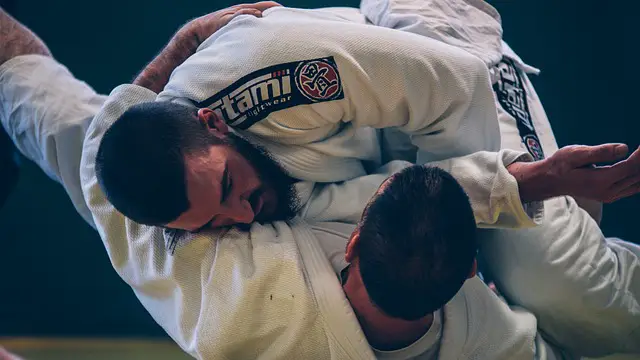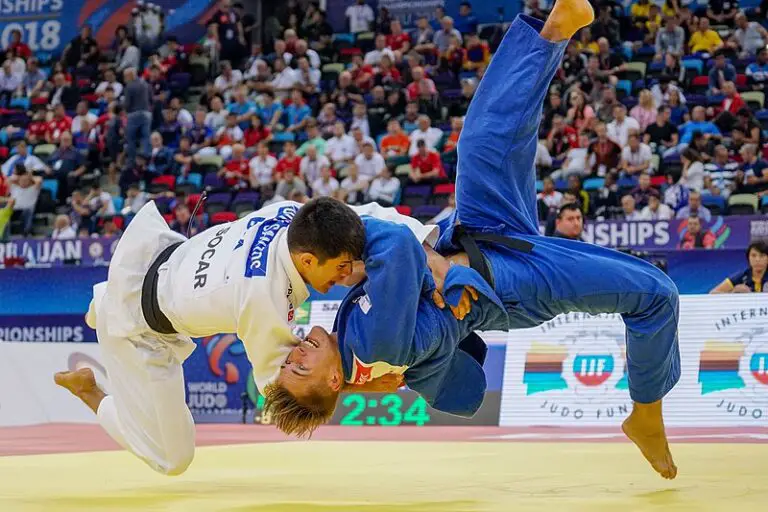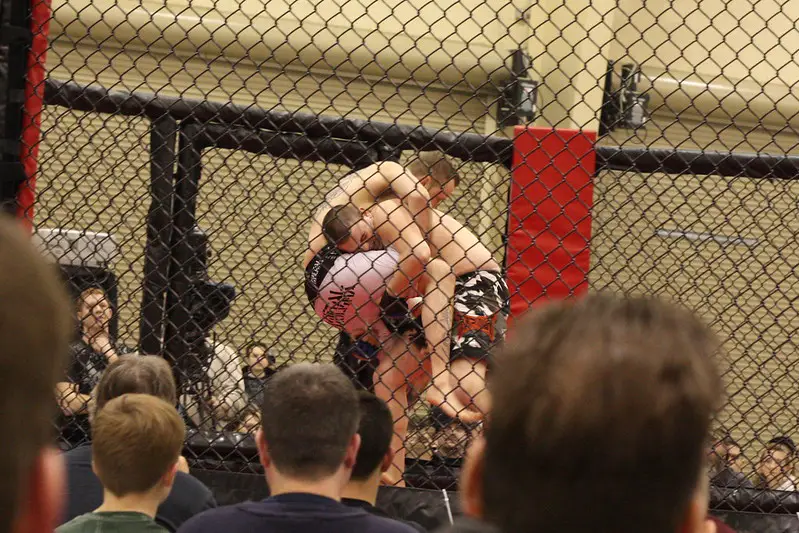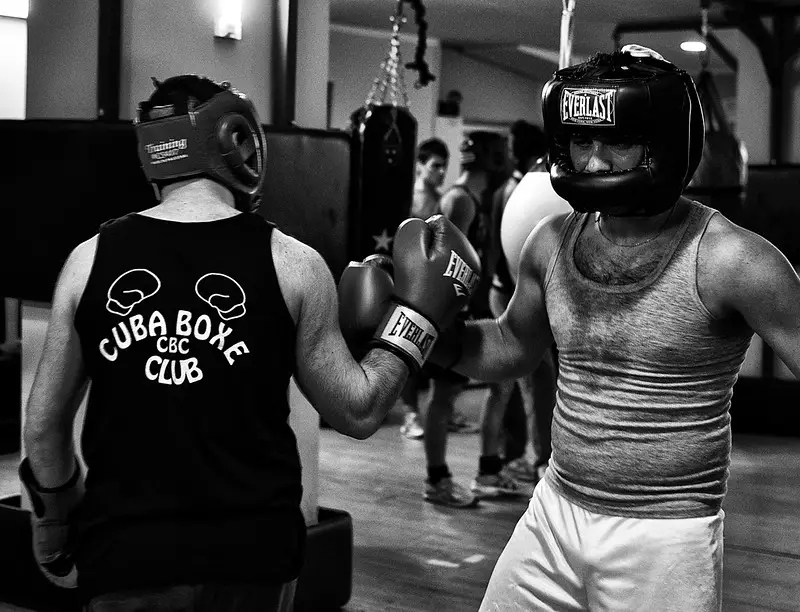Though primarily known as a popular Olympic sport, many people wonder if is judo effective for street fighting and whether an individual can use judo skills in a self-defense situation.
Is Judo Good For Self-Defense and Street Fighting?
Judo as a concept fits well within the physical and mental demands of street fighting. Thus, it represents a solid option for people looking for self-defense training. Its skills are practical for self-defense, especially during the range exchanges where judokas can secure a strong grip, and execute one of many throws.
The other key advantage is safety as judo techniques enable you to neutralize the attacker without hurting them, which is important. The physicality of judokas and their ability to throw the attacker off balance in the blink of an eye works well against regular people.
Superior to other styles
First, the majority of people do not know how to grapple. Defending against punches and kicks is easier as this involves our natural reactions.
But judo is all about balance, leverage, technique, and weight distribution. Regular people not trained in grappling do not have the skills and instincts needed to defend against these attacks. That requires years of practice.
Plus, street fighting is not a pro-match where two people fight at a distance. No, most scenarios involve a lot of grabbing and pulling at close range, which suits judo well.
In places like a bar where most fights happen, you often do not have enough space to dive for takedowns or throw kicks and manage distance. This is where upper-body grappling comes into play as a very effective method.
Safe to apply
One important aspect is the safety of techniques. Kickboxing, for instance, is effective on the streets but also very dangerous as it can cause severe injuries. This includes concussions, fractures, internal bleeding, etc.
Judo is much safer because it enables you to neutralize the attacker using methods that do not cause severe injuries. Or at least there is a much lower chance someone will get hurt. Taking someone down does not hurt the same as blasting them with a shin to the head.
Powerful throws
Judo’s throws, like the inner thigh throw (Uchi Mata) and hip throw (Koshi Guruma), are effective ways to unbalance the opponent in a real fight. Since these moves are technical, it also means you can execute them without much resistance as most people do not know defensive procedures.
Also, slamming a person down to a hard surface can be dangerous. So you have to be careful executing these moves.
Once in a real fight, judokas need to secure just a solid grip on the attacker to throw them off balance and secure a takedown.
Effective pins and ground control
Once the fight hits the ground, judokas use positioning, holds, and pins to quickly neutralize the attacker. According to studies, a lot of street fights end up on the ground at some point, and knowing how to fight there gives you a big advantage.

Once on the ground, most people panic and move like fish in the dry. You can use this to your advantage to quickly establish the position, and neutralize them with locks or holds. Just securing a position is often more than enough for the attacker to surrender.
Instead of hurting the attacker with strikes, immobilizing them with holds is a much safer option.
Limitations of Judo for Self-Defense
The key disadvantage of judo for self defense t is the lack of striking techniques, as well as its heavy sports orientation and point fighting rules.
Practitioners need to be aware that Judo is not designed for self-defense, but rather for competition. Although the concept fits well with certain self-defense scenarios, you have to also be aware of the following limitations.
Distance management
Judo is all about the grips and executing throws from a standing position. In certain scenarios, putting your skills to work might be a challenge, especially if the fight happens in the open and you are facing an opponent who knows a thing or two about the movement. By managing distance, they can easily pick you apart with decent long-range striking before you can get a hold of them.
Lack of striking techniques
Judo predominantly focuses on throws, takedowns, and groundwork, neglecting striking techniques commonly found in other martial arts. This limitation can be a drawback in situations where effective strikes are necessary for immediate deterrence or incapacitation.
Heavy emphasis on competition
The learning program revolves around competition. Practitioners learn how to obey the rules and win points and matches, not how to fight on the streets.
Judo competition rules often discourage or prohibit certain practical self-defense techniques, such as strikes and joint locks, which are essential in real-world confrontations.
Moreover, the scoring system in Judo competitions prioritizes specific throws and techniques for points, potentially influencing practitioners to favor those techniques over others that might be more effective in self-defense, where the primary goal is personal safety.
Limited effectiveness in multiple attacker scenarios
Judokas may face challenges to put their skills to work in scenarios where they have to deal with multiple attackers. While Judo teaches valuable skills against one opponent, managing simultaneous threats from different directions can be complex and demanding.
And initiating a takedown against multiple attackers is suicidal.
Judo Self Defense Moves That Work In Real Life
Here are some of the best judo self-defense moves:
- Osoto-gari (Large Outer Reap). This is one of the fundamental throws in judo. It involves off-balancing your opponent by pulling them forward and then sweeping their leg out from underneath them.
- Ippon Seoi Nage (One-arm Shoulder Throw). This throw involves gripping your opponent’s sleeve and collar, then rotating them over your shoulder and onto their back. It’s effective in close-range encounters.
- Ouchi-gari (Major Inner Reap). This technique involves reaping your opponent’s inner leg while maintaining control of their upper body. It’s particularly useful when your opponent is moving backward.
- Tai Otoshi (Body Drop). Tai Otoshi is a sacrifice throw where you drop your body weight under your opponent’s center of gravity, using your leg to trip them as you fall. It’s effective against opponents who are charging forward.
- Kesa Gatame (Scarf Hold). This is a pinning technique used to control an opponent on the ground. By wrapping your arm around their head and securing their arm, you can immobilize them effectively.
- Ude-garami (Arm Lock). While primarily a submission technique, Ude-garami can be used for self-defense by controlling and potentially dislocating your opponent’s arm if they attempt to strike or grapple with you.
- Kata Guruma (Shoulder Wheel). This throw involves lifting your opponent onto your shoulders and then rotating them over and onto the ground. It can be effective in close-quarters combat situations.
Is Judo Good For MMA?
Judo plays a valuable role in MMA, notably inside the clinch position which is important in freestyle combat. Judokas are superior here with their effective trips and throws, and it’s really hard to stop their attacks.
However, judo on its own won’t help you much in MMA. You must combine these skills with the others from Thai boxing and wrestling to develop an all-around game. In the end, the one-dimensional approach does not work in cage fighting.
Pros of Judo in MMA:
- Effective Throws and Takedowns. Judo’s throws, like hip throws and foot sweeps, can be powerful tools for initiating striking exchanges or taking opponents to the ground. Plus, MMA fighters do not drill judo moves often so the surprising effect plays a big role too.
- Ground Control and Transitions: Judo’s groundwork, particularly its emphasis on pins and transitions, can aid MMA fighters in controlling opponents on the mat. It also provides a good base for learning BJJ which is conceptually similar.
- Clinch Advantage: Judo in the clinch is what boxing is on the feet or BJJ on the ground. Once a judoka secures a grip or lock, the opponent has limited escaping options, none in most cases.
Cons of Judo in MMA:
- Limited Striking Training. Judo lacks the striking components essential in MMA, requiring practitioners to supplement their training with disciplines like boxing or Muay Thai to develop a well-rounded skill set.
- Lack of advanced groundwork. Judo is not as efficient on the ground as BJJ for instance. Thus, trained BJJ fighters may exploit gaps in Judokas submission defense and overall ground game.
- Struggles in Defensive Wrestling . Judo primarily focuses on clinch work. Thus, its fighters may have a hard time stopping proper wrestling attacks they are not trained for.
Can You Use Judo Without the Gi Uniform?
Judo grips and throws can be used without the gi uniform. While the gi provides grips and handles for throws and controls, practitioners can modify techniques to suit the absence of a gi.
But they must be skilled enough to adapt quickly to specific settings that come with street fighting, and that might be challenging.
If there are no grips available on the clothing, judokas may switch their attacks to grabbing the arm, torso, securing a neck, shoulder, or other limbs and body parts to establish a dominant position and execute the throw.
However, people do not walk around naked. In most situations, you would have a peace of cloth to grab on. This includes a leather jacked, which is very similar to a judogi uniform and you can manipulate it in the same way. Hoodies, sweaters, or even T-shirts can also be used to a great extent.
The Importance of Cross-Training
To make judo effective for street fighting, you need to combine it with striking at least. Real-world fighting is unpredictable and you can prepare for all of them. But expanding your arsenal improves your chances of escaping unharmed.
Thus, the majority of judokas looking to develop all-around skills cross-train in different arts. The most popular options are boxing, Muay Thai, and MMA, systems that complement their grappling game.
Also, there are other systems that entirely focus on self-defense such as Krav Maga. Apart from conventional techniques, Krav Maga also teaches verbal tactics, de-escalation, dirty moves, and many other essential skills.
Final Thoughts — Is Judo Effective For Street Fighting?
Overall, judo skills are practical in real combat situations and may help you neutralize the attacker and escape without the injuries. Though not the best or most comprehensive, no one can deny the power of judo techniques when it comes to close-range combat.
Despite the lack of striking skills, judo remains one of the best foundations when it comes to real combat. From powerful throws, trips and takedowns to body control and ground holds, Judo works well in different street fighting scenarios an individual may face in real life. Later on, you can use this strong grappling foundation to cross-train in other styles and develop all-around skills.
Best Grappling Martial Arts (Top 5)


